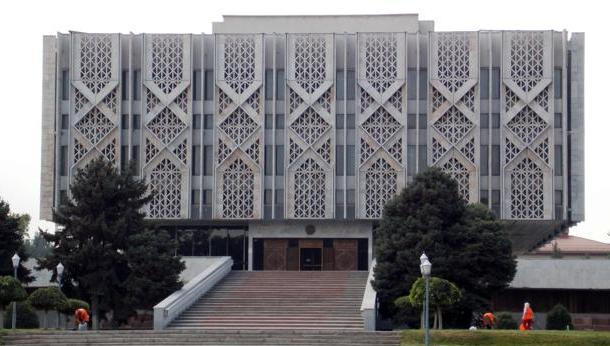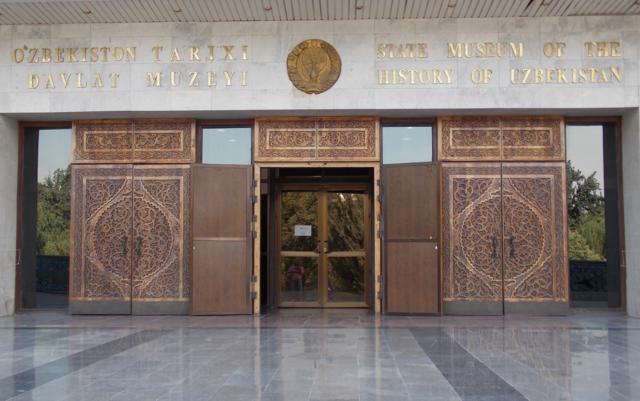O vizita la muzeul de istorie nationala ar trebui sa constituie inceputul fiecarei calatorii intr-o tara straina pentru ca ofera cadrul general in care s-a dezvoltat acea tara si cateva dintre elementele esentiale ale culturii acelui popor. Nici Muzeul Istoriei Nationale din Tashkent nu se abate de la aceasta regula.
Fondat in 1876 ca Muzeu National al Turkestanului, acesta este primul muzeu public din Asia Centrala. Cladirea muzeului a fost ridicata in 1970, in stilul sovietic al vremurilor, avand totusi o influenta locala in acele paravane de protectie impotriva soarelui, din marmora, fixate pe exterior. Acestea se numesc “panzhara” in limba uzbeka. Initial, cladirea a adapostit Muzeul Lenin.
Muzeul de Istorie Nationala, Tashkent
Hunii, turcii si arabii au invadat pe rand teritoriul actualului Uzbekistan, de-a lungul a aproape 700 de ani, distrugand dar si lasand in urma lor elemente de cultura proprie care s-au imbinat armonios in timp cu cea autohtona. Aducand pe aceste pamanturi Islamul, nenumarate moschei si madrase (sau medrese – scoli religioase islamice) au fost construite in marile orase de pe drumurile caravanelor (Khiva, Bukhara, Samarkand). Unele dintre ele, foarte bine pastrate, sunt vizitate astazi de milioane de turisti din lumea intreaga, care vin sa se bucure de forme si culori neobisnuite pentru ei, precum si de o atmosfera a timpurilor de mult apuse, care mai poate fi inca simtita mai ales la Khiva.
Inainte de a face acesta excursie nu stiam nimic despre istoria Uzbekistanului. Sigur ca, daca nu esti specialist, sau pasionat de istorie, e greu sa retii bogatia de date. Doua lucruri am retinut acum, mai ales. Unul (legat de istoria europeana) este prezenta in zona a lui Alexandru cel Mare, ajuns aici dupa ce a traversat Muntii Hinducus, in anul 329 inainte de Christos. Dupa lupte grele pe malul fluviului Sirdarya, Alexandru invingator s-a casatorit cu Roxana, printesa sogdiana, inrudindu-se astfel cu elita locala. Celalalt se refera la Tamerlan, proeminenta figura istorica a evului mediu, care a creat un imperiu urias, intins de la Volga pana in India. Stiam despre el cateva lucruri vagi, dar acum a fost mereu prezent in tot ceea ce am vazut. El si dinastia intemeiata de el au avut un rol pregnant asupra istoriei locurilor si a Asiei in general. In bataliile sale a ajuns si in Europa, capturand Moscova in 1395. Contemporan cu sultanul Bayazid al Imperiului Otoman, dupa moartea acestuia a ramas o amenintare pentru intreaga Europa, care se temea de o eventuala invazie. Ambitia sa de a cuceri China a scapat insa Europa si i-a adus moartea.
detaliu
Muzeul are 9 sectiuni si infatiseaza istoria Uzbekistanului din epoca de piatra pana in prezent. Din numarul mare de exponate se disting:
Buddha, sec. I-III A.D.
Bodhisatva, sec. I-III A.D.
stele funerare turcesti, sec. VI-VII A.D.
fragment decorativ femeia-pasare, sec. VI-VII A.D.
Se mai pot vedea costume traditionale din diverse zone sau vase si bijuterii lucrate artistic de mesterii artizani.
Muzeul se poate vizita zilnic intre 10-18. Intrarea costa 6000 sum (cam 3$) dar fotografiatul atinge suma mult prea mare de 20000 sum (aprox. 10$). Il puteti gasi in apropierea Pietei Independentei, pe str. Rashidov.
On the Silk Road in Uzbekistan 6. The National History Museum
The Huns, the Turks, and the Tatars invaded Uzbekistan during a 700 years period, destroying but also leaving behind elements of their own culture which combined with the local one. Numerous madhrasses (Islamic religious schools) and mosques have been built in the big towns on the caravans’road. Some of them, very well preserved, are visited today by millions of tourists.
The Huns, the Turks, and the Tatars invaded Uzbekistan during a 700 years period, destroying but also leaving behind elements of their own culture which combined with the local one. Numerous madhrasses (Islamic religious schools) and mosques have been built in the big towns on the caravans’road. Some of them, very well preserved, are visited today by millions of tourists.
I knew almst nothing about the history of Uzbekistan before I went into this trip. I retained mainly two things. One, related with the European history, is about the Alexandre’s the Great presence in the area, after he crossed the Hindukush Mountains. He married the Sogdian princess Roxana, to relate with the local nobility. The other one is about Tamerlane, prominent historical figure, who created a huge empire extended from Volga to India. He greatly influenced not only the Turkestan history but also that of Europe. On 1395 he captured Moscow. Reigning in the same time with the Bayazid Sultan of the Ottoman Empire, after his death, Tamerlane remained a threat for Europe. His huge ambition to conquer China brought him death, and saved Europe.
Vising the Museum of National History should be the first step in every trip to another country. Thus, one can understand the general frame for that country development in time, and also figure out some cultural elements.
The National History Museum of Uzbekistan, founded on 1876, was the first public museum in Central Asia. The actual building which house the museum was built on 1970 in a Soviet constructivist style. Still a local influence is manifested in the “panzhara”, those sun protecting screens, made of white marble on the exterior face.The museum is organized in 9 sections, from the stone age till today. I put some photos here, illustrating the most valuable or interesting artefacts.
The museum is open daily between 10-18. Entrance is 6000 sum (aprox. 3$) but the right to take photos is more expensive – 20000 sum (aprox. 10$).



I like the statues.
Thanks for these nice shots…… i like the details very much……you show us very good and special pictures.
Greetings, Joop
Thanks, Randy. I wish you a nice weekend!
Thank you for the visit, Joop. Have a nice weekeend!
You knew nothing about the history of Uzbekistan before this trip was accepted, but now you know a lot more Nice report and photos.
Nice report and photos.
Very nice weekend.
Fabulous. What made you go to Uzbekistan? That carved door is brilliant, as are the textiles.
Yes, Helma, I do now. Thank you. Have a nice weekend!
Thanks, Francisca! I explained in post no.1 of this series what made me to go there. The 1001 nights story made a great impression on me in my childhood, and also all what I learned or heard about the Silk Road. I always wanted to visit Bukhara, Khiva and Samarkand, and now it was the proper time!
The collection is impressive, your images captivating. Again a wonderful post TH :^)
Este un lucru excelent ceea ce reusesti tu sa faci,sa realizezi o adevarata enciclopedie despre locurile pe care le vizitezi.Si mie mi-a placut “1001de nopti”,mi-am imaginat acele locuri,dar niciodata nu m-am gandit sa la vizitez.Felicitari pentru munca si talentul tau.
Thanks, Doug, for your constant presence here!
mircea, multumesc pentru aprecieri. Poate ceea ce vezi iti da idei si intr-o zi le vei vizita si tu:)
Great museum,and the collections are stunning.Accessories are gorgeous.Statues are awesome.
I’m also interested in Tamerlane’s story.
Japanese temples and museums should use this system : a fee to take photos.
I can’t agree more, Kumiko:) In my next post you will find details about Tamerlan. Thanks for the comment!